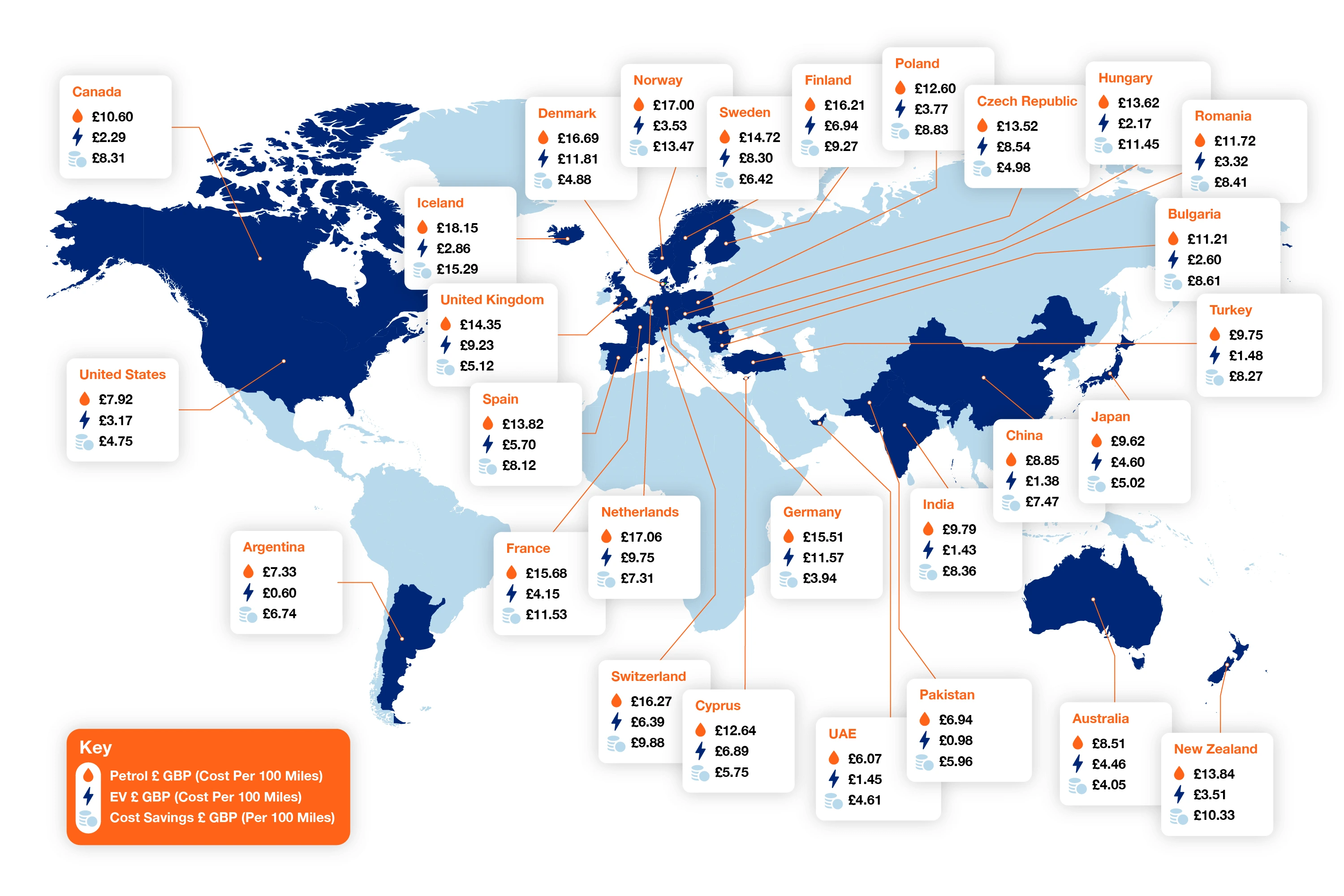The cost of running an electric vehicle vs petrol car in 33 countries
09 Sep 2023

Contents
- Introduction
- Comparing the Data
- EV vs Petrol Price Index
- EV vs Petrol Price Index: An Analysis
- Recognising Charging Rate Variability
- Cost Savings Through Incentives
Introduction
With the global shift towards sustainable transportation gaining momentum, the transition from petrol-powered vehicles to electric has become a focal point for over 30 countries across the world. Trailblazing this change, Norway stands poised to eliminate petrol and diesel vehicles from its roads as early as 2025. While the goal to phase out internal combustion engine (ICE) vehicles is undoubtedly ambitious, a recent study by Kantar pinpoints the persisting challenges. In the UK (56%) and the US (55%) for example, the upfront cost of electric vehicles (EVs) remains a prominent barrier to their adoption.
However, data from the International Energy Agency strikes an encouraging narrative. Sales figures indicate an increase in demand for electric cars, projected to surge by 35% in 2023. With the upfront EV costs expected to mirror their conventional petrol and diesel counterparts by 2025 or 2027, the trajectory for EV sales is likely to gain even more momentum.
This trajectory aligns seamlessly with the visions of numerous countries, particularly those within the European Union, all set on achieving climate neutrality by 2050. While the environmental merits of EVs are apparent, an important question emerges: What implications do these shifts hold for individual wallets?
The economic contours of EV ownership present a mix of clarity and ambiguity. Elements such as upfront purchase costs, EV home charge point installation, insurance, and maintenance still have question marks against them. Yet, there is a consensus that when it comes to day-to-day operational expenses, powering an EV at home offers a more budget-friendly alternative to refuelling a petrol-powered vehicle.
However, the precise extent of savings for EV owners compared to their petrol counterparts, as well as the variances across different nations, demand further exploration.
As investors in Indra Renewable Technologies, Gulf Oil International has embarked on a comprehensive data analysis to offer insight into which countries will benefit the most from lower operating costs.
Comparing the Data
Comparing the operational costs of petrol and electric cars across diverse countries is a complex endeavour. It is riddled with variables – charging infrastructure, electricity tariffs, and a plethora of car models.
However, undaunted by the complexity, we delved into the world of data, drawing from Global Petrol Prices to capture electricity and petrol price insights.
Anchoring our analysis, we identified the most prevalent petrol and electric car models, extracting their average maximum range (in miles) on a full tank/battery and their corresponding tank/battery capacities.
The result? A top-level snapshot of the comparative landscape.
So, what are we comparing?
 |
|
|---|---|
|
The 'Average' Petrol Car MPG: 45.2 Fuel Capacity: 48 litre / 10.5 gallons (UK) |
The 'Average' EV Car Range: 239 miles Battery Capacity: 57 kWh |
Our ‘average’ petrol car and ‘average’ EV car form the basis of our analysis into the running costs of petrol and EV cars across 33 countries.
Our analysis revolves around these ‘average’ examples of petrol and electric cars. By studying the average statistics of the most common cars, we were able to compare the costs of running them in 33 different countries.
EV vs Petrol Price Index
EV vs Petrol Price Index: An Analysis
Across all the countries we examined, opting for an 'average' EV car proved more budget-friendly than going with an 'average' petrol car. Yet, the extent of savings for EV drivers differs.
Leading the pack in terms of savings are Iceland, Norway, France, Hungary, and New Zealand. For instance, in Iceland, covering 100 miles in a petrol car costs £18.15, while an EV car covers the same distance for just £2.86, translating to £15.29 saved per 100 miles. Similarly, Norway sees EV drivers pocketing approximately £13.47 in savings for every 100 miles, and in France, the amount saved stands at around £11.53.
On the flip side, countries like Austria, Italy, Belgium, Ireland, and Qatar exhibit more modest differences in price between petrol and electricity. Consequently, the benefits for EV drivers in these regions are more restrained. Take Austria as an example: cruising 100 miles in an average petrol car sets you back £13.70, whereas an EV covers the same distance for £13.05, resulting in a mere 66p saving. In Italy, the difference amounts to roughly £1.38, while in Belgium, it's £2.75.
Recognising Charging Rate Variability
It's important to acknowledge the inherent limitations of our high-level analysis, which centres solely around domestic charging stations without accounting for tariff adjustments or public charging prices that can influence costs.
To demonstrate this, let’s consider the case in the UK, where energy provider OVO presents a "charge anytime" tariff at a rate of £0.10* per kWh (15/03/23). This equates to an expense of £2.38 for 100 miles in an 'average' EV passenger car. This stands in stark contrast to the cost of £9.23 incurred when using a non-discounted domestic charger for the same distance.
These nuanced tariff structures underscore the need to delve into localised charging rates and incentives, which can significantly impact the economic dynamics of EV ownership.
Our analysis provides a broad perspective, highlighting the important role that governments play in incentivising EV ownership with favourable energy tariffs.
Cost Savings Through Incentives
The uptake of electric vehicle (EV) ownership hinges upon the financial considerations that people face when contemplating the transition from ICE. Our analysis shows that although the operational costs of EVs are universally lower, there is a divergence among various nations. The success of Norway’s EV adoption so far is not coincidental; it is supported by a range of cost-saving incentives.
EV Incentives in Norway
Registration Tax Benefits
Battery electric vehicles (BEVs) have been exempt from registration tax since 1990.
Plug-in hybrid electric vehicles (PHEVs) have tax benefits, including deductions on the total weight used for determining the taxation rate.
Ownership Tax Benefits
BEVs and PHEVs pay reduced annual road tax and only a scrapping fee for circulation taxes.
Purchase Subsidies
Drivers of electric vehicles are exempt from purchase tax, CO2 tax, weight tax, and VAT benefits.
VAT Benefits
BEVs are exempt from VAT on purchase and leasing.
The VAT exemption for zero-emission vehicles has been approved until a certain date.
Local Incentives
Grants for upgrading/establishing charging infrastructure in housing associations and co-owners in different municipalities.
Maximum grant amounts per charging point or housing association.
EV Infrastructure Incentives
Regulations on electric vehicle supply equipment (EVSE) allocation in new buildings and parking lots.
Budget allocation for EVSE deployment by housing associations.
Well-established fast-charging stations along main roads.
Electric Car Association Charging Chip
Access to charging units across the country at a reduced price through the Norwegian Electric Car Association.
Other
Special E-Number plates for EVs, providing local incentives such as free parking and bus lane access.
Access to different parking fee structures in various municipalities.
Access to bus lanes for electric vehicles with multiple occupants.
Exemption from regional toll road fees, with a reduced fee starting from a certain year.
Free access to most ferries on the national road network.
Source: https://alternative-fuels-observatory.ec.europa.eu/transport-mode/road/norway/incentives-legislations
These incentives and legislation contribute to making electric vehicles more financially attractive to Norwegian citizens. They address various aspects of EV ownership, including purchase costs, taxes, charging infrastructure, and other associated expenses, leaving no room for doubt that running an EV is more cost-effective than petrol
Conclusion
Our deep dive into the world of everyday EV versus petrol running costs reveals something that sustainable mobility isn't just about being kind to the environment – it's also a smart economical move if you are able to accommodate domestic charging. While navigating through the maze of different pricing structures might seem tricky, one thing is crystal clear: the shift away from traditional engines is strongly tied to technological developments and the efforts of governments.
Aside from implementing robust charging infrastructure, fast moving advancements in battery technology are likely to accelerate EV adoption and further enhance cost-effectiveness when it comes to charging. Advances in battery chemistry, such as solid-state batteries, promise higher energy density, faster charging times, longer lifespans and improved safety. These developments could lead to EVs with longer ranges, shorter charging times, and lower maintenance requirements.
Similarly, the development of superconductors has the potential to revolutionise electric motors and power delivery systems in EVs, significantly reducing energy losses during transmission, resulting in more efficient power transfer and improved overall vehicle efficiency. This could lead to longer battery life and reduced energy consumption, ultimately lowering operating costs.
Countries like Norway are winning the race when it comes to EV adoption and have incentivised the switch to electric since 1990. As countries around the world push towards hitting targets for eliminating ICE, more and more governments around the world are starting to turn attention to incentives.
Advancements in technology and the push for EV adoption through incentives and pocket-friendly energy tariffs for both domestic and public charging, will no doubt help to steer us towards a future where we can enjoy greener vehicles that make economic sense too.

